
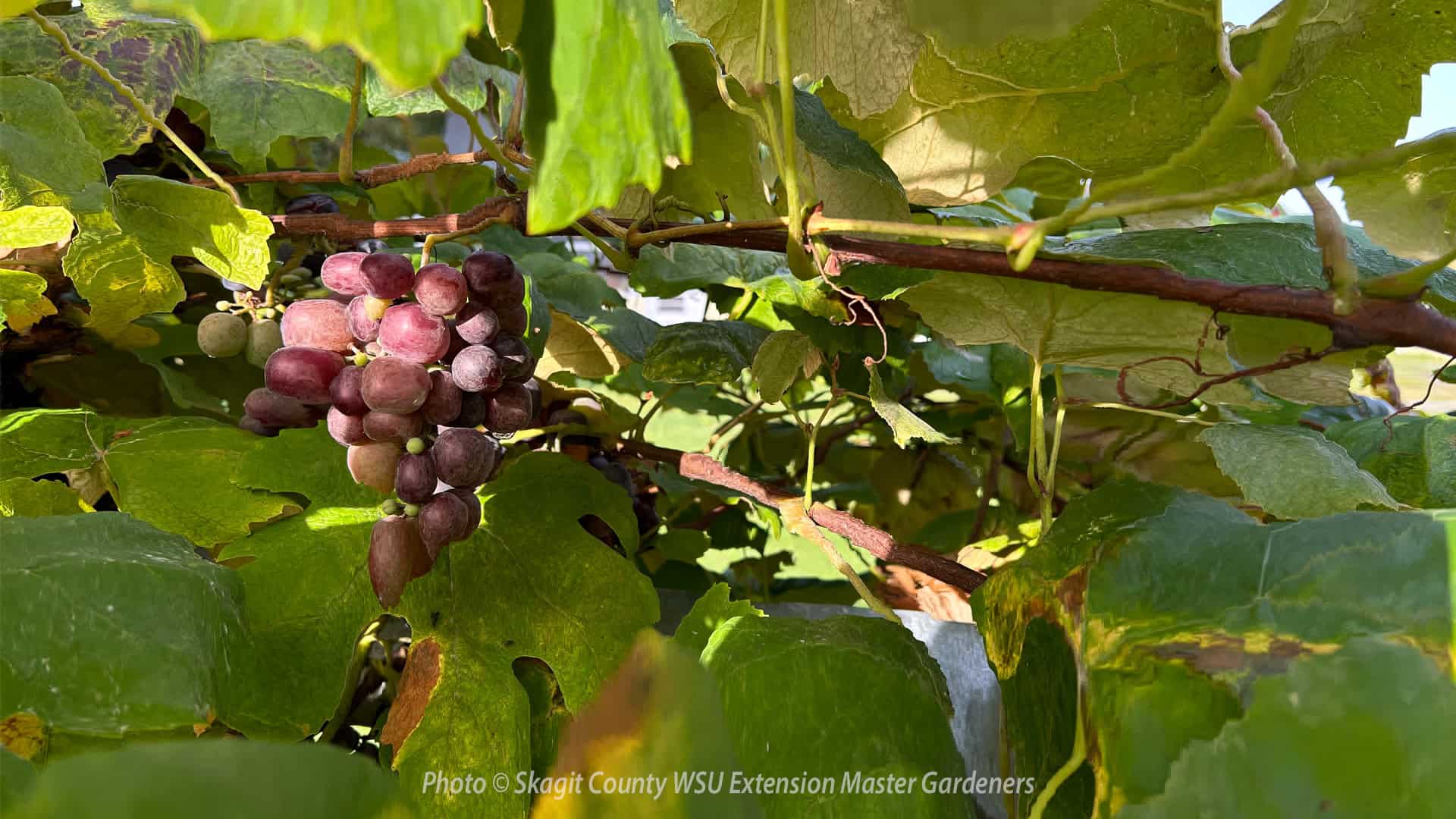
Growing Grapes in Western Washington
Enjoy fresh, home-grown grapes by choosing the best varietals and location.
Subscribe to the Blog >By: Kathy Wolfe, Skagit County WSU Extension Master Gardener
Do you ever dream of strolling through your garden on a warm summer day, popping juicy, succulent grapes into your mouth, and experiencing the liquid nectar explode? This does not have to be a fantasy for gardeners west of the Cascades. With the proper site, preparation, and varietal choice, you can enjoy fresh table grapes, juice, jelly, raisins, and even wine on your property if your growing area is large enough here in our maritime climate.
Our region averages somewhere between 20-60 inches of rain, depending on where you are located. As we have experienced, less rain falls during the summer than during the rest of the year, in contrast to the grape-growing regions in Italy, France, and Germany.
Mildew is generally kept at bay with our long days of light, little cloud cover, clean air, and pleasant breezes. Our challenge is having enough warm days (heat units) to allow the grapes to reach their full potential. Choosing the best varietals and planting them in the warmest, sunniest area possible can help develop grapes to their optimal ripeness, flavor, and acidity.
Most vines in Western Washington are grown on rootstock, as opposed to the own-rooted vines of Eastern Washington. Rootstock helps improve cluster size. Choosing variety and rootstock combinations that work best in our cool climate conditions has been an important part of research in Washington over the last decade. Be aware that Washington state has strict grapevine quarantines. Only certified plant material is allowed to be brought into the state.
|
WSDA Certified Plant Material The Washington State Department of Agriculture (WSDA) certifies plant materials entering the state and recommends using certified materials. Nurseries growing plant stock participate in a voluntary program which certifies the stock from which they were produced has been inspected and tested in accordance with procedures and requirements outlined by the state agency. A list of in-state nurseries that sell certified grapevines can be obtained by contacting the Clean Plant Center Northwest through their website at https://cpcnw.wsu.edu/ |
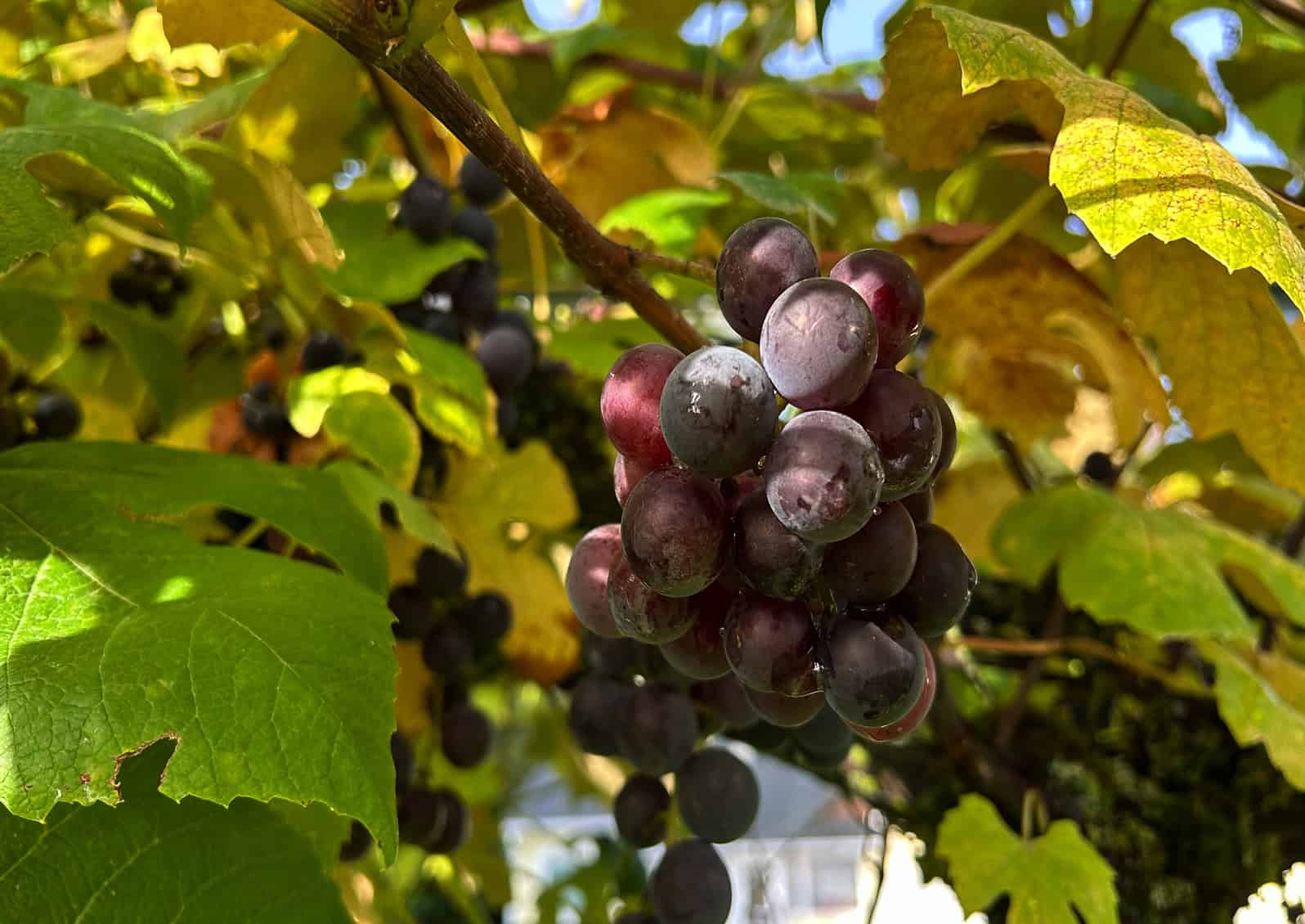
Concord grapes grow well in sunny locations in Skagit County. While lower in tannins needed for wine making, Concord grapes are considered heart-health and excellent for juice and jelly making. Photo: © Ginny Bode
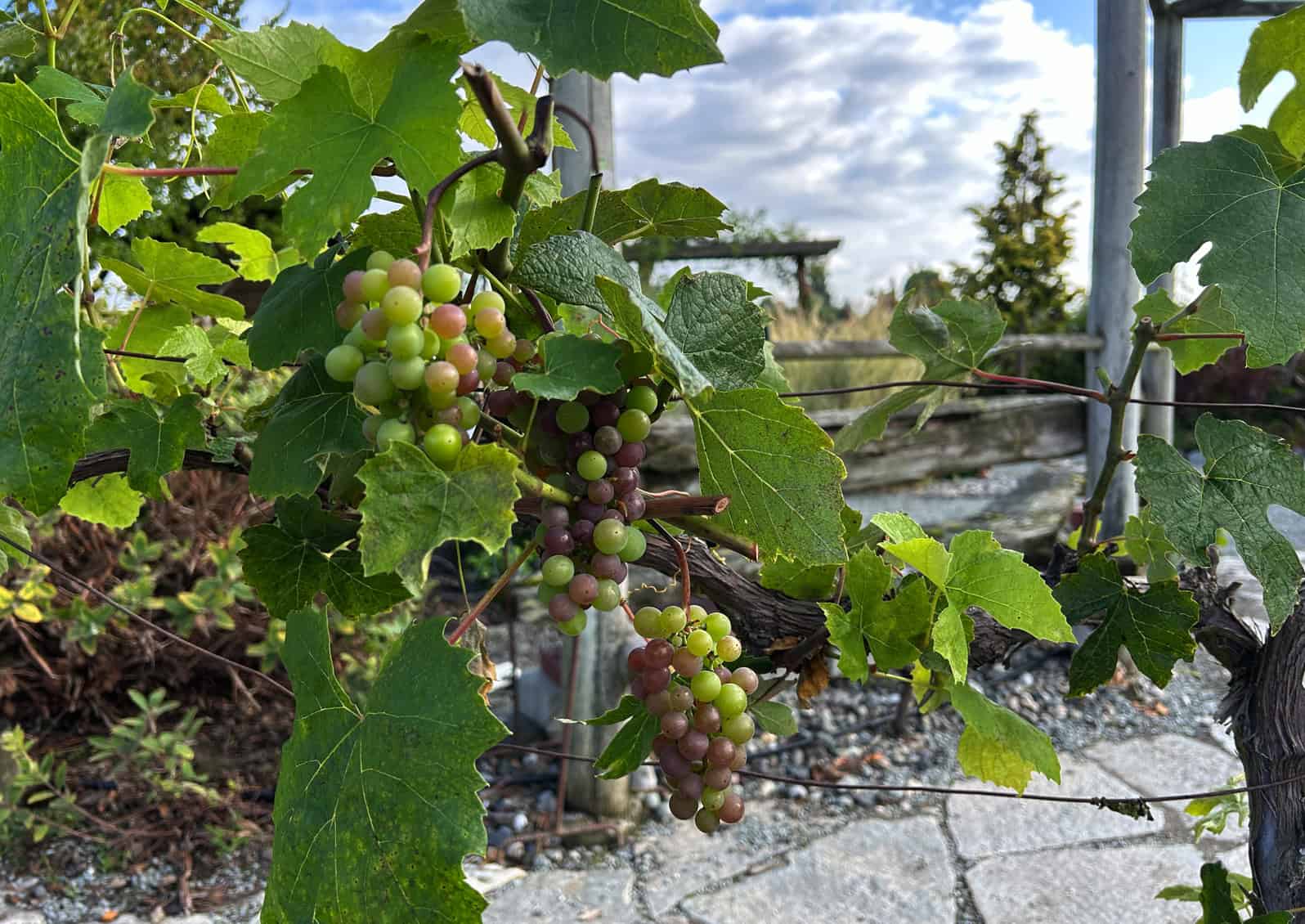
A grape arbor is a beautiful addition to any garden. Edelweisse, a hardy, disease resistant, large white grape, grows on “Doc’s Arbor” in the Discovery Garden. Photo: © Ginny Bode
Ever wonder why the same grape can produce different flavors in different areas? The site’s geography, geology, and climate (heat, rain, sunshine, elevation, slope, aspect, and soil), combined with the plant’s genetics, create a unique flavor and characteristic fruit in an area. This unique individuality of flavor is called “terroir” from the French “terre” or land.
A sunny spot with warmth and air circulation is a must when growing either table or wine grapes. South, southwest, or westerly-facing slopes are generally the best heat producers.
Grapes are trained on wires or trellises (different systems for table and wine grapes are used) and generally planted in north/south facing rows. Spacing between rows should be about 8 or 9 feet so that the 6-foot-high vegetation will not shade the adjacent row except early or late in the day. Individual plants can be planted 4 to 6 feet apart.
Grapes prefer well-drained, sandy, or gravelly soils for heat retention. Well-established plants can’t be transplanted, so choosing your site and preparing the soil thoroughly before planting is important.
If possible, cultivate the area where you will be planting the year before, get a soil test to determine any soil nutritional deficiencies and correct them. Make sure the area is weed-free before planting your vines.
To maximize soil heat, avoid areas prone to early spring frost or in a valley where cool air accumulates. You can plant your vines on a mound surrounded by stones to increase warmth near the plant roots. Grass growing near vines can lessen the vigor of the plant’s growth, so removing the grass is beneficial.
Plant grafted grapes to promote early ripening and better resistance to root diseases. It is extremely important when planting grafted vines that the graft is planted well above the finished soil level. The vine will settle in the dirt, so factor this into your planting depth.
Apply organic matter to the soil before you plant in the spring or fall. Compost can be worked into the entire area, not just each hole. Organic mulches cool the soil, so avoid using them. Dark-colored gravel or rocks warm the soil and keep weeds down. Dark-colored poly mulches can be used, but if you have voles, be aware that they will likely find shelter under the plastic layer.
It may be necessary to use low nitrogen fertilizers after the first year because grapes can grow aggressively and deprive the soil of nutrients. An annual application of lime or sulfur-potassium-magnesium with micronutrients can be beneficial to raise the pH to the desired 6.8-7 range.
Irrigation is especially important in the first two years while your vines establish themselves. Pruning and training canes is dependent on whether you are growing table or wine grapes and can vary slightly with every grape variety and the age of your vines. For more information on trellising and pruning, look up the “Study of Grapes and Wine with WSU” at the Viticulture & Enology (https://wine.wsu.edu/extension/grapes-vineyards/), or Oregon State University’s “Growing Table Grapes” publication at https://extension.oregonstate.edu/catalog/pub/ec1639
It will take two to three years before your first harvestable crop and five to six years for grapes to reach full production maturity. Plants have been known to live for 50-100 years with proper care.
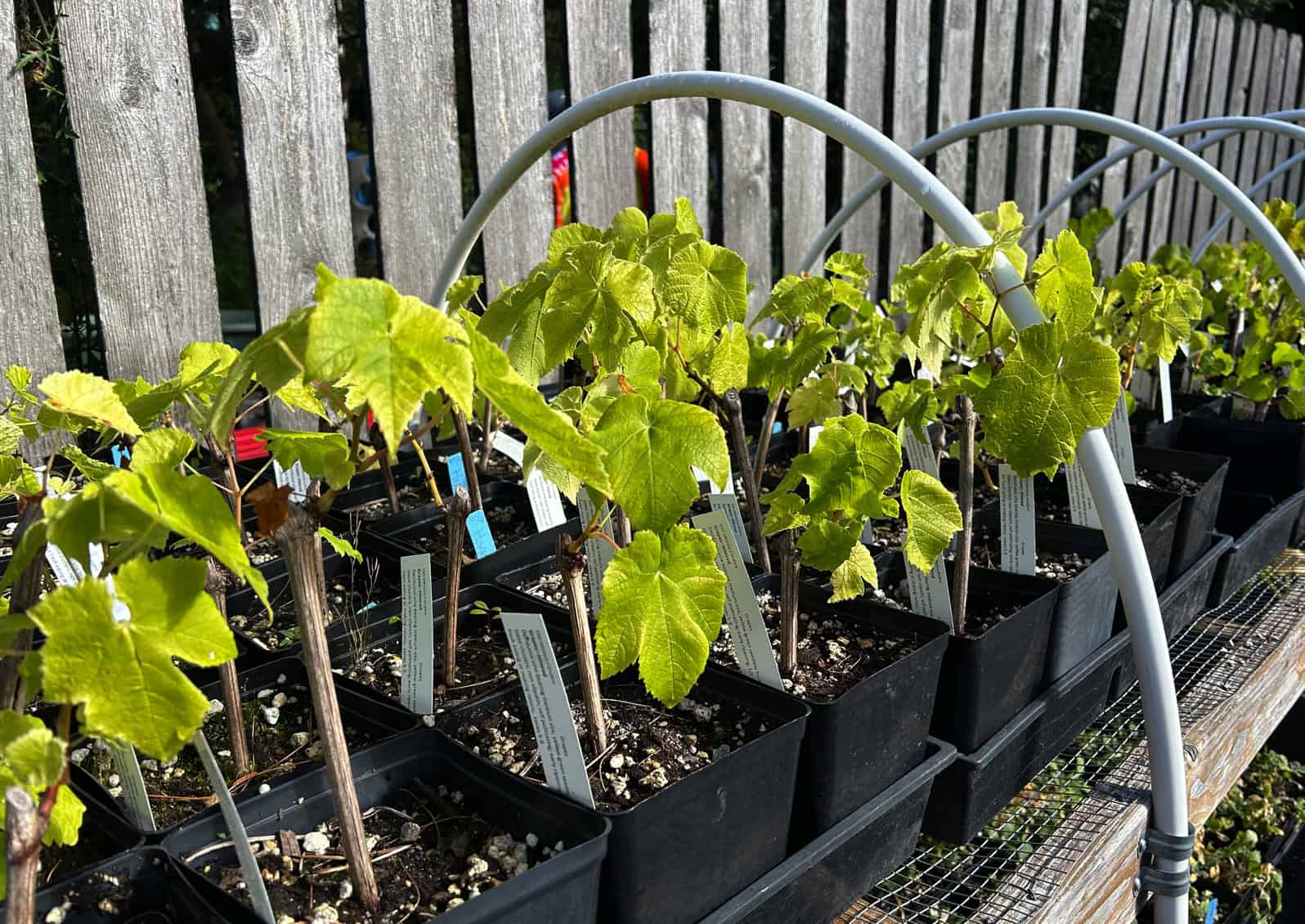
As with any plant, it is important to purchase virus-free stock. For the annual plant fair in May, master gardeners propagate nine varieties of grapes from stock obtained from certified plants. Photo: © Ginny Bode
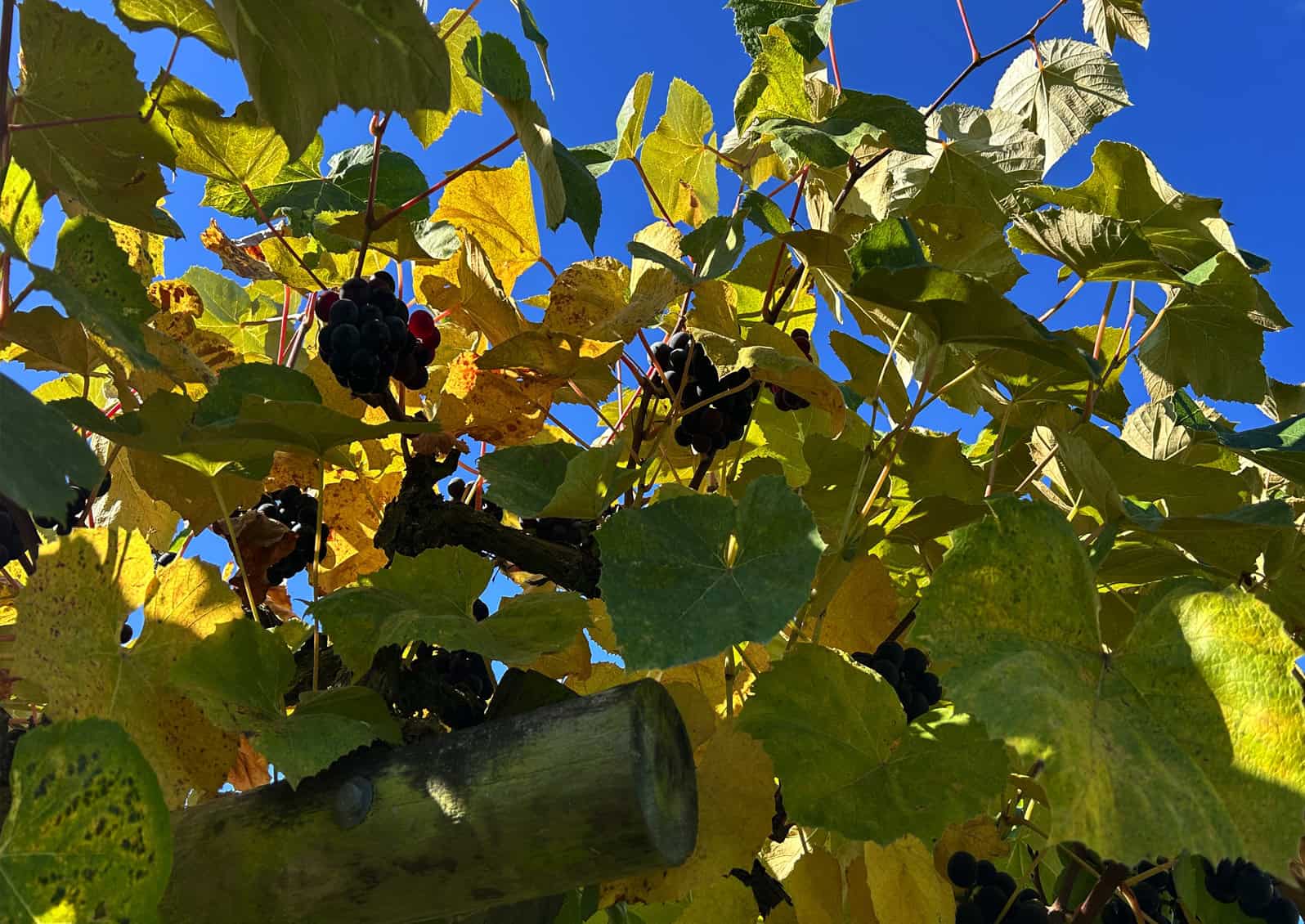
This Vitis lambrusca x vinifera ‘Lynden Blue, growing in the NW Fruit Garden is a great choice for gardeners in cool summer areas who want the full, rich taste of a Concord-style grape, but don’t have the GDD (Growing Degree Days) to ripen actual Concord fruit. Photo: © Ginny Bode
Grapes ripen all at the same time. Color varies with each cultivar. Watch for color change in the stem that supports the cluster, as it will change from green to brown. The seeds also darken as the berry matures.
The best way to judge ripeness in table grapes is a taste test: pick a grape from the tip of the cluster as it is the last to ripen. When growing wine grapes, use a refractometer to measure sugar content (known as Brix) to determine when to harvest.
Use pruning shears to harvest clusters. Don’t leave ripe grapes on the vine because they deteriorate quickly. Store them in vented plastic bags in the refrigerator.
Watch the weather around harvest time. Rain can cause cracking or splitting and increase fruit rot. The best quality is obtained when berries are harvested following two to three days of no rain.
As for pests, deer will eat the plants, so if you have a deer problem, you will need to provide a 7-8-foot fence to keep them out. Birds also find grapes a tasty treat. You might want to net the plants if you lose more to our feathered friends than you can spare.
Like the time it takes for grapes to reach harvest age, it takes years to become an expert grape grower. Look for Washington State University Extension workshops or those offered by trusted local nurseries, as well as publications from WSU Extension (extension.wsu.edu) or through other university articles to get a good place to start.
Dream no more of having your own vineyard and begin planning now. There is no time like the present; your journey will be worth the reward.
REFERENCES AND RESOURCES:
Moyer, M., Henick-Kling, T. (2014). Growing Winegrapes in Maritime Western Washington. Washington State University Extension #EM068E. Retrieved from: https://pubs.extension.wsu.edu/growing-winegrapes-in-maritime-western-washington-replaces-eb2001
Strik, B. (2011, rev. 2023). Growing Table Grapes. Oregon State University Extension #EC1639 Retrieved from: https://extension.oregonstate.edu/catalog/pub/ec1639
Grapevines. Clean Plant Center Northwest. Washington State University. Retrieved from: https://cpcnw.wsu.edu/grapevines/
Study of Grapes and Wine with WSU. Grapes & Vineyards | WSU Viticulture and Enology | Washington State University Retrieved from: https://wine.wsu.edu/extension/grapes-vineyards/
Taylor, J. Growing Backyard Grapes in the Puget Sound Region. NW Fruit, Mount Vernon, WA. Retrieved from: NWFruit.org >
Pike, D. (Apr. 2015). Growing Grapes in the Northwest, Grow Northwest. Retrieved from: https://grownorthwest.com/2015/04/growing-grapes-in-the-northwest/

Kathy Wolfe
ABOUT THE AUTHOR:
Kathy Wolfe has been a Skagit County WSU Extension Master Gardener since 2002. She is co-manager of the vegetable garden at the Discovery Garden on SR 536 west of Mount Vernon.
Become a
Master Gardener in 2025,
applications due Oct. 31.

Questions about becoming a Master Gardener may be directed to: Skagit County WSU Extension Office, 11768 Westar Lane, Suite A, Burlington, WA 98233; by phone: 360-428-4270; or via the website: https://extension.wsu.edu/skagit/mg/